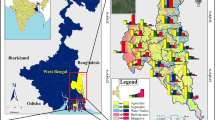Abstract
In contrary to the numbers of qualitative studies, there is few quantitative studies have been done on defining climate zone boundaries and on illustrating differences inside a zone. In order to find quantitative methods to demarcate a physical geography boundary and to reveal the agro-climatic resources differences of the South Subtropical Zone in Fujian Province of China based on the data collected from limited and discrete weather stations, this research tries to develop models that use mathematics methods and Geographical Information System (GIS) technology. Three modeling methods - Discriminant Analysis, Trend-surface with Residual (TSR) Analysis, and Digital Elevation Model (DEM) were applied in the study to produce a distribution grid system of a set of indicators, and to define the spatial location of the zone boundary precisely. The results of the study show that the outputs of the models have very high significant level in statistical tests.


Similar content being viewed by others
References
“Chinese physical geography” editorial committee of Chinese Academy of Sciences (1984) Chinese physical geography (climate). Science Press, Beijing
Dang A, Jia H, Yi S (2002) Geographic information system application guide to ArcGIS 8 desktop. Tsinghua University Press, Beijing
Ge J et al (2010) Integrated physical geography. Science Press, Beijing, pp 52–65
He X (2012) Multivariate statistical analysis. China Renmin University Press, Beijing
Hong N, Hou J (2001) Statistical analysis system tutorial of SAS for windows. Publishing House of Electronics Industry, Beijing, pp 193–202
Huang B (1958) A primary draft of comprehensive natural regionalization in China. Acta Geograph Sin 24(4):348–365
Huang B (1984) DR. Zhu Kezhen and his scientific investigations of tropical China and Hainan Island (1) — the demarcation of tropical and subtropical belts of China. Geogr Res 3(1):8–14
Huang B (1992) On the boundary of tropics in China: I. Definition of tropical and subtropical zones in internation. Sci Geogr Sin 12(2):97–104
Jiang A (1960) On classification of tropical and subtropical zones in China. Acta Geograph Sin 26(2):104–109
Liu C, Yue T, Zhou C (2000) Mathematical model and application on geography. Science Press, Beijing, pp 35–71
Qiu B (1984) Several problems about the research of subtropical zone. J Southwest Normal Univ 9(2):45–54
Ruan G, Cai J, Jian L (2003) The bible of using SAS statistical analysis. Tsinghua University Press, Beijing, pp 474–483
Su J, Fu R, Zhou J (2000) Practical guide to statistical software SPSS for windows. Publishing House of Electronics Industry, Beijing, pp 478–492
Tang G (2012) Experimental course on spatial analysis in geographic information system to ArcGIS. Science Press, Beijing
Tang G, Li F, Liu X (2010) Tutorial of digital elevation model. Science Press, Beijing
Wu X et al (2002) Principle and method of geographic information system. Publishing House of Electronics Industry, Beijing, pp 168–176
Wu G et al (2008) Physical geography. Higher Education Press, Beijing, pp 140–154
Wu J, He B, Li H (2011) Geographic information system application tutorial to ArcGIS 9.3 desktop. Tsinghua University Press, Beijing
Xie L, Shang T (2012) SAS statistical analysis and data Ming. Publishing House of Electronics Industry, Beijing
Xu J (2002) Mathematical method in contemporary geography. Higher Education Press, Beijing, pp 37–105
Xu Z, Lou Y (1994) Mathematical foundation on geology. Beijing University Press, Beijing, pp 47–48
Xue W (2011a) Statistical analysis and SPSS application. China Renmin University Press, Beijing
Xue W (2011b) Data analysis based on SPSS. China Renmin University Press, Beijing
Yan L (1988) The numerical division of the boundary between the middle and south subtropical belts in Fujian Province. Sci Geogr Sin 8(2):181–187
Yan L (1990) Application of modern mathematical method in evaluation the agro-climatic resources of the south subtropics in Fujian Province. Trop Geogr 10(2):97–105
Yan L (1999) Application of extension engineering method to division of physical geography boundary [J]. Geogr Res 18(1):53–58
Yan L (2011) Models of regional agro-climatic resources survey and system assessment based on Geo-spatial data mining. In: Yee L et al (eds) 2011 IEEE international conference on spatial data mining and geographical knowledge services (ICSDM 2011). Institute of Electrical and Electronics Engineers, Inc, Beijing, pp 435–439
Yang Q, Zheng D, Wu S (2006) On subtropical zone of China. J Subtrop Resour Environ 1(1):1–10
Yu X, Ren X (1999) Multivariate statistical analysis. China Statistics Press, Beijing, pp 101–153
Zhang Q (1990) Trend-surface analysis on geology. Science Press, Beijing, pp 6–84
Zhu K (1958) Subtropical zone in China. Chin Sci Bull 8(17):524–528
Author information
Authors and Affiliations
Corresponding author
Additional information
Communicated by: Hassan Babaie
Rights and permissions
About this article
Cite this article
Yan, L. Numerical identification models on the boundary and agro-climatic resources differences of the south subtropical zone in Fujian Province of China based on GIS. Earth Sci Inform 6, 21–29 (2013). https://doi.org/10.1007/s12145-012-0109-8
Received:
Accepted:
Published:
Issue Date:
DOI: https://doi.org/10.1007/s12145-012-0109-8




